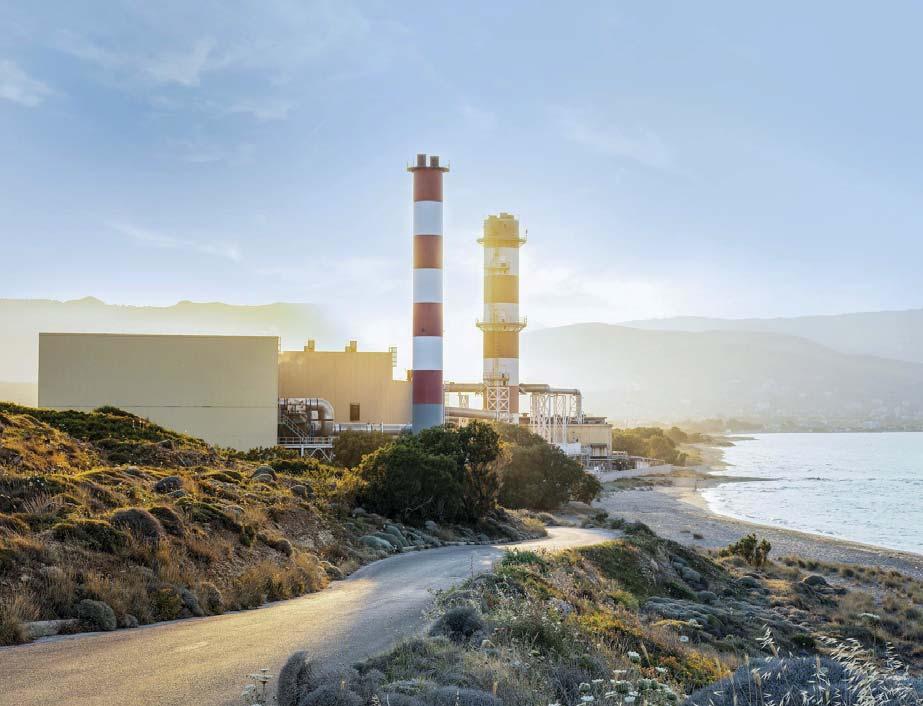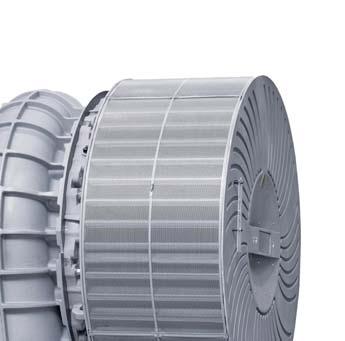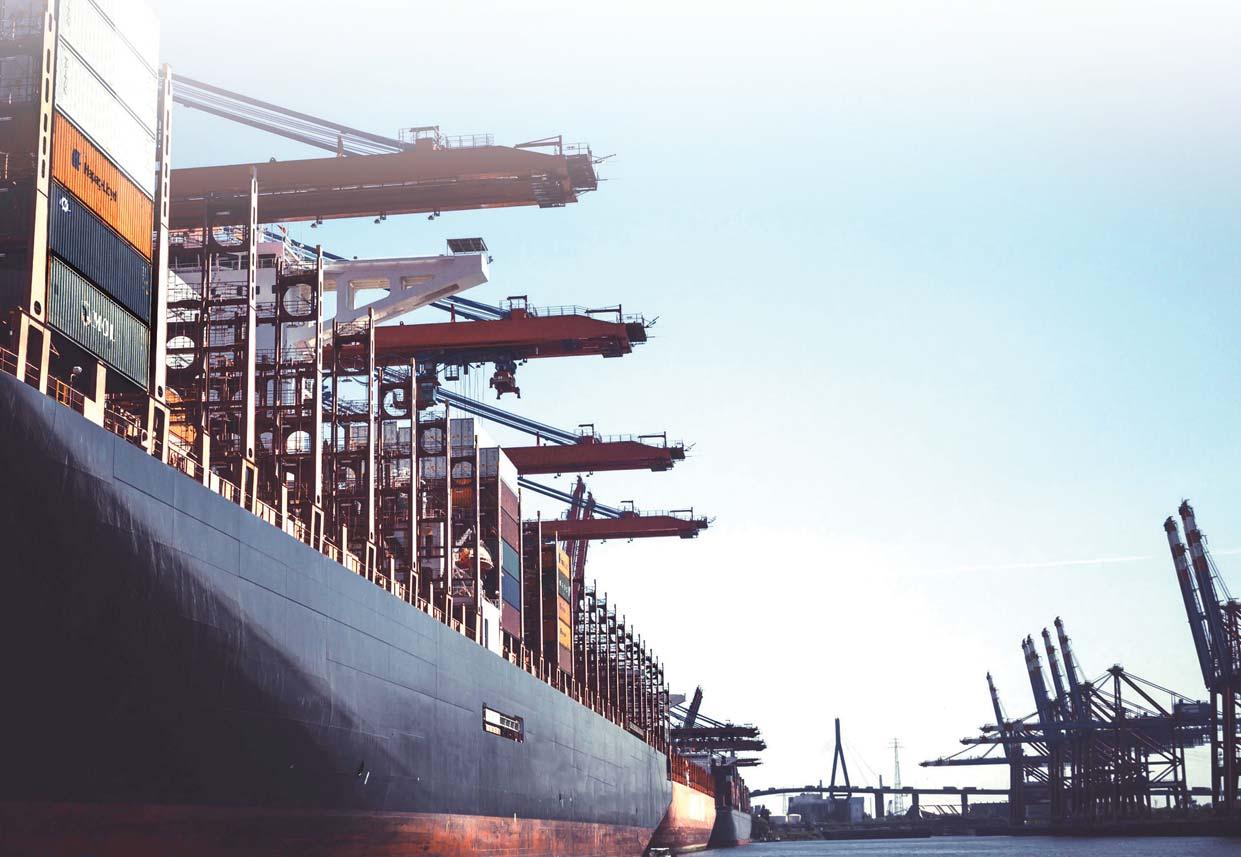
8 minute read
ROFKA BRINGS CHANGES IN THE TURBOCHARGING MARKET
Christoph Rofka, Accelleron’s president Medium & Low Speed products and VP Communications at CIMAC, discusses changes that are affecting the wider maritime propulsion market, and Accelleron’s response in an exclusive interview with The Motorship
8 Christoph Rofka noted that techno-economic comparisons between CCGTs and ICEs for energy generation reserve capacity were changing as higher levels of renewable energy capacity entered regional and national grids
Before turning to Accelleron’s own activities, Rofka took stock of the intense pace of technological development taking place in the large bore engine market. The technical programme for the upcoming CIMAC congress in Busan in June 2023 revealed the range of areas in which industry participants have been working on solutions.
Rofka also agreed that the depth and breadth of the programme was a testament to the industry’s response to the IMO’s target of reducing greenhouse emissions by 50% by 2050, compared with 2018.
“The decarbonisation targets have transformed research, which [had been] dominated by traditional targets such as higher efficiency, higher power density, and new engine types… before the industry began to take the IMO targets seriously. But we’re seeing a completely different dynamic [and] a different level of spending by engine manufacturers and their partners on R&D.”
Rofka was keen to stress that the current momentum was not restricted to the marine industry, and that a number of promising developments are emerging in the energy market.
Looking ahead, Rofka noted that the International Maritime
Organisation (IMO) was expected to discuss proposals to introduce more ambitious greenhouse gas (GHG) emission reduction targets at the MEPC80 meeting in June.
“Regardless of whether the IMO strengthens its efficiency goals, it is clear that the maritime industry will need to embrace alternative so-called Net Zero Carbon fuels. For ocean going vessels, this will mean that the current propulsion system, with a low-speed main engine directly coupled to the propeller, is here to stay. So the challenge is that this technology has to be ready and available to burn future fuels. And this is where, of course, all the key technology providers, including us at Accelleron, have to play their part.”
Rofka noted that in addition to LNG, the current range of alternative fuels for the marine market include methanol, while the first green ammonia projects are expected to be delivered after 2025.
The emergence of the first large-scale green ammonia export projects, such as the 1.2 million tonnes per year NEOM green ammonia project in Saudi Arabia which was approved a few days before the interview on 1 March, were expected to be positive in terms of creating demand for carriers, which in turn would create demand for dual fuel engines capable of running on the alternative fuel as fuel.
“It is important for our industry to move forward with confidence, because this is no time for placing bets on something exotic. Given the tight timeframe, you have to get it right from the beginning. And there's not too much time for, let's say, trying out fundamentally different routes that potentially lead to nowhere.”
Ammonia implications for turbos
From the perspective of a technology supplier, Rofka noted that the development of technology solutions for alternative fuels was an interesting challenge. The Motorship notes that this is particularly the case for ammonia, where the first full scale engine tests have yet to be undertaken.
The uptake of dual-fuel ammonia engines is likely to be running ahead of the establishment of ammonia bunkering availability. This early ramp up period was likely to see vessels continue to operate on diesel-like secondary fuels. As a result, the engine concepts are initially expected to remain close to those currently used. From a turbocharging perspective, the difference is that the expected rise in fuel prices is likely to drive a focus on efficiency and specific fuel consumption.
However, if fuel availability ceases to represent a key constraint on specifying alternative fuel engines in the future, we will expect to see an increasing number of pure-ammonia engines. Rofka noted that while hydrogen was not currently expected to play a significant role in deep-sea shipping, it had quite distinct combustion characteristics.
ICEs in stationary markets?
Rofka noted that one unexpected consequence of decarbonisation requirements was that it mightn reveal new opportunities for ICE installations in stationary markets.
The rapid rise in renewable energy generation that is being seen in many parts of the world is creating additional demand for power generation capacity with very high response rates to stabilise the grid. The need for accompanying investments in load balancing capacity becomes increasingly important once the proportion of renewable power generation from solar power or wind powered sources exceeds a certain threshold for a variety of technical reasons, including the possibility of natural
The emergence of monofuel engines operating on ammonia or hydrogen would be likely to see engine specifications change “quite a bit” from today’s requirements. This would pose some challenges as monofuel NH3 or monofuel H2 engines were likely to evolve in completely opposite directions. Engineers would be likely to rely on richer burning strategies to overcome ammonia’s recognised weak flammability and poor ignitability characteristics.
The high flame speed and highly ignitable nature of hydrogen combustion means that engineers would increase air to fuel ratios combustion, which would lead to higher pressure operations on the turbocharger compared to current solutions.
Faster development techniques

This means that Accelleron is swiftly preparing for the emergence of demand for new turbocharger solutions within highly compressed timeframes. Rofka noted that Accelleron already commenced by simplifying its portfolio and by fundamentally altering its product development model.
Rofka explained in an interview with The Motorship in May 2022 that Accelleron was seeking to introduce a modular design approach towards technology development, in which fl uctuations in wind and solar generation, as well as the inertia certain types of power plant provide the grid.

Combined cycle gas turbines have come to replace internal combustion engines for power generation purposes, as their responsiveness and the low cost of natural gas have made them attractive solutions to meet peaks of energy supply alongside base load generation.
However, Rofka noted that the introduction of renewable energy generation at high levels into some local and national grids was creating different loading patterns, with reserve power generation sometimes standing idle for extended periods of time, which was changing the economics of CCGT comparisons against ICEs. component level advances (in the turbine or compressor stages) could be introduced into the turbocharger design platform as advances occur. In parallel, Accelleron was examining the possibility of introducing a design platform specifically designed to allow the core of the unit to be replaced during port stays.
CCGTs tend to suffer from low cycle fatigue when started up irregularly to a greater extent than ICEs, while ICEs also tend to have a higher efficiency over a wider load range than CCGTs, which are typically ‘tuned’ for an optimal load.
Rofka noted that while batteries can meet short-lived spikes in demand, ICE based capacity might be able to meet longer-term fluctuations in demand.
“We are seeing projects from US, Italy, the UK and in Ireland,” Rofka said.
This opportunity in the power market was quite distinct from existing demand for ICEs for base load power generation in geographically remote areas , islands or an urgent need for capacity build-up.


Earlier engagement with industry partners was likely to offer advantages in contributing to the capture of requirements earlier in the product development cycle. This was also a logical response to a fast-evolving market where the future demands for turbocharger solutions and the pathway of development is no longer predictable for the next five years or more.
“It's completely different [now]. We are going forward, and we learn as we go forward. And then we have to adapt fast. So that's a completely different philosophy, and then we have to adapt our processes accordingly.”
“For us it is strategically key that we position ourselves on the most relevant future fuel engine platform developments. So it's not only then to provide hardware for testing, that that feels best and but also to support with engine performance simulation.”
Low speed turbocharging launch
The modular design strategy, collaborative working approach with engine builders, and integrated digital and physical asset approach outlined by Rofka are expected to form part of Accelleron’s upcoming low-speed turbocharging solution launch.
The approach to low-speed turbocharging is still on track to be unveiled at the CIMAC Congress in June in Busan. Accelleron still plans to bring the new concept to market by the end of 2024.
But the concept is expected to go beyond the simple introduction of alternative turbocharger configurations into the low-speed maritime market.
Development tests conducted in 2023 had confirmed that the solution would make a significant improvement in efficiency levels. “Our ambition remains that we want to be the turbocharger maker with the highest efficiency levels and that will not change,” Rofka said firmly.
But Rofka stressed that the modular design was also expected to act as an enabler for quite advanced future service concepts that cannot be implemented today from a design perspective.
The solution was also expected to integrate digital elements into Accelleron’s service offerings. “So the new hardware together with digital and our service capabilities amount to a service offering that is a step change, if not an evolutionary leap.”
Future development possibilities
While the development of solutions for alternative fuel powered engines is a major focus for Accelleron at present, Rofka did note that the company was studying nascent technologies, like fuel cells, for potential product niches. There were certain prerequisites for such technologies to attract Accelleron’s interest, including a close relationship with the internal combustion engine. In addition, they were expected to include a strong service element to be compatible with its existing product portfolio.
One such opportunity might exist in the application of turbocharger technology to fuel cells, where the technology can be used to increase the output and efficiency of fuel cells. Fuel cell technology still needs to overcome some technical and commercial hurdles and is unlikely to become commercially viable in the short term. Rofka was at pains to note that despite a flurry of small-scale pilot projects, there was little prospect of fuel cells entering into the marine market before the end of the current decade.
Off-highway expansion plans
Christophe Rofka also noted that as an independent company, Accelleron was free to pursue commercial opportunities in other segments of the market.
The company has begun Intensify its activities in the high speed diesel engine market, and has already launched its first dedicated products.
Rofka noted that the off-highway Market, which is currently below Accelleron’s product coverage in term of engine power and served by turbocharger makers from the automotive industry, provides interesting opportunities.
The automotive market was highly competitive, and faced longer term challenges as electrification and the introduction of hybridisation were likely to reduce the importance of the internal combustion engine in the segment over the medium term. As a result, some suppliers were choosing to exit the market.
However, the challenges facing competitors in the automotive space were likely to create opportunities for established OEMs like Accelleron in the off-highway market. Rofka noted that the off-highway market was unlikely to electrify to a similar extent as on-highway, owing to wellknown challenges with power densities, which would create a demand for solutions capable of handling engines operating on alternative fuel. “But then they won't have the technology supply from the automotive sector. While we believe that that offers a potential entry for us to extend our portfolio towards the [high-speed] end, it's a long journey.”
8 Accelleron is planning to introduce a novel approach to low-speed turbocharging at the CIMAC Congress in June in Busan, South Korea
Powering shipping’s emissions-cutting ambitions
Learn from C-suite keynote panel
Keynote panel topic: The cost of decarbonisation & who is going to pay?
Some of the topics you can expect to discuss with the keynote panel will include carbon levy funding, funding for investment, national incentives, funding for new technology & hypothecation.
Sponsored by:


Book your place now and save 20%
Secure your place at the 44th Propulsion & Future Fuels Conference, the leading technical conference that provides:
A meeting space for the latest innovation in transoceanic zero-carbon shipping Technical solutions for decarbonising the shipping sector of 5,100 ships Multiple networking opportunities.

Supported by:










